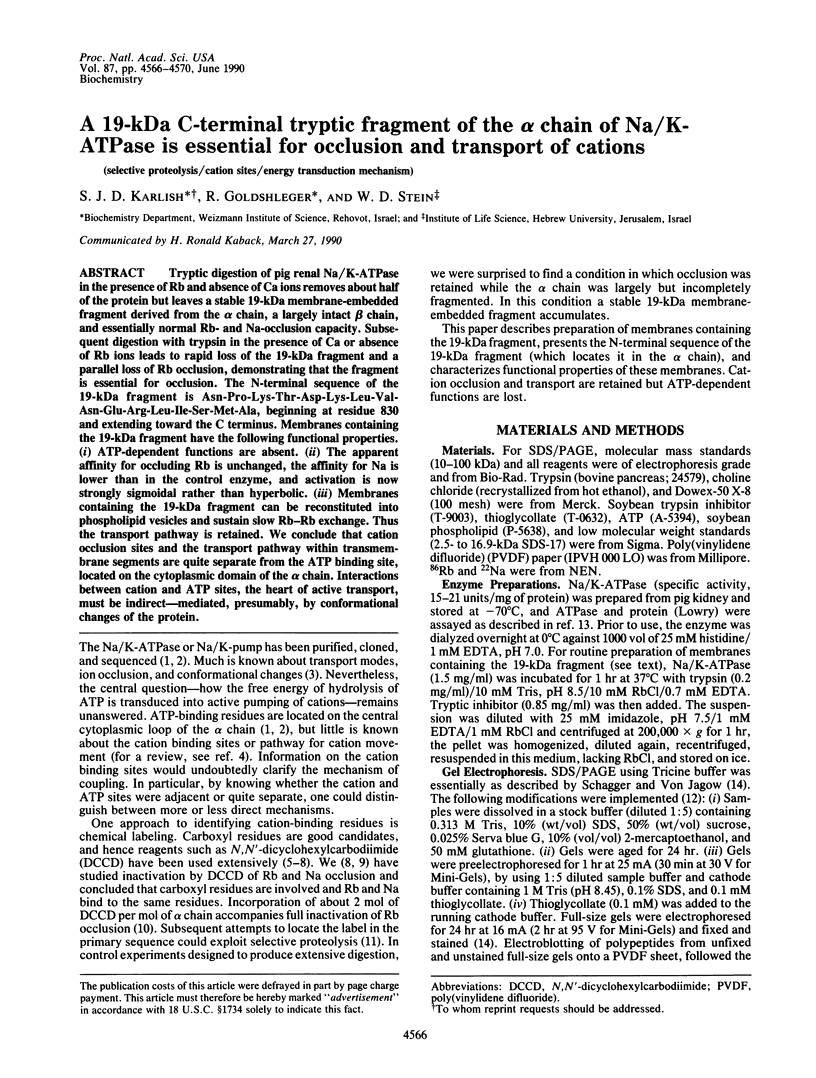Abstract
Tryptic digestion of pig renal Na/K-ATPase in the presence of Rb and absence of Ca ions removes about half of the protein but leaves a stable 19-kDa membrane-embedded fragment derived from the alpha chain, a largely intact beta chain, and essentially normal Rb- and Na-occlusion capacity. Subsequent digestion with trypsin in the presence of Ca or absence of Rb ions leads to rapid loss of the 19-kDa fragment and a parallel loss of Rb occlusion, demonstrating that the fragment is essential for occlusion. The N-terminal sequence of the 19-kDa fragment is Asn-Pro-Lys-Thr-Asp-Lys-Leu-Val-Asn-Glu-Arg-Leu-Ile-Ser-Met-Ala, beginning at residue 830 and extending toward the C terminus. Membranes containing the 19-kDa fragment have the following functional properties. (i) ATP-dependent functions are absent. (ii) The apparent affinity for occluding Rb is unchanged, the affinity for Na is lower than in the control enzyme, and activation is now strongly sigmoidal rather than hyperbolic. (iii) Membranes containing the 19-kDa fragment can be reconstituted into phospholipid vesicles and sustain slow Rb-Rb exchange. Thus the transport pathway is retained. We conclude that cation occlusion sites and the transport pathway within transmembrane segments are quite separate from the ATP binding site, located on the cytoplasmic domain of the alpha chain. Interactions between cation and ATP sites, the heart of active transport, must be indirect--mediated, presumably, by conformational changes of the protein.
Full text
PDF




Images in this article
Selected References
These references are in PubMed. This may not be the complete list of references from this article.
- Bayer R. Topological disposition of the sequences -QRKIVE- and -KETYY in native (Na+ + K+)-ATPase. Biochemistry. 1990 Mar 6;29(9):2251–2256. doi: 10.1021/bi00461a007. [DOI] [PubMed] [Google Scholar]
- Forbush B., 3rd Rapid release of 42K or 86Rb from two distinct transport sites on the Na,K-pump in the presence of Pi or vanadate. J Biol Chem. 1987 Aug 15;262(23):11116–11127. [PubMed] [Google Scholar]
- Glynn I. M., Howland J. L., Richards D. E. Evidence for the ordered release of rubidium ions occluded within the Na,K-ATPase of mammalian kidney. J Physiol. 1985 Nov;368:453–469. doi: 10.1113/jphysiol.1985.sp015868. [DOI] [PMC free article] [PubMed] [Google Scholar]
- Glynn I. M., Karlish S. J. Occluded cations in active transport. Annu Rev Biochem. 1990;59:171–205. doi: 10.1146/annurev.bi.59.070190.001131. [DOI] [PubMed] [Google Scholar]
- Gorga F. R. Inhibition of (Na+,K+)-ATPase by dicyclohexylcarbodiimide. Evidence for two carboxyl groups that are essential for enzymatic activity. Biochemistry. 1985 Nov 19;24(24):6783–6788. doi: 10.1021/bi00345a009. [DOI] [PubMed] [Google Scholar]
- Jorgensen P. L. Purification and characterization of (Na+ plus K+ )-ATPase. IV. Estimation of the purity and of the molecular weight and polypeptide content per enzyme unit in preparations from the outer medulla of rabbit kidney. Biochim Biophys Acta. 1974 Jul 12;356(1):53–67. doi: 10.1016/0005-2736(74)90293-4. [DOI] [PubMed] [Google Scholar]
- Jorgensen P. L. Purification and characterization of (Na+, K+)-ATPase. V. Conformational changes in the enzyme Transitions between the Na-form and the K-form studied with tryptic digestion as a tool. Biochim Biophys Acta. 1975 Sep 2;401(3):399–415. doi: 10.1016/0005-2736(75)90239-4. [DOI] [PubMed] [Google Scholar]
- Jørgensen P. L., Andersen J. P. Structural basis for E1-E2 conformational transitions in Na,K-pump and Ca-pump proteins. J Membr Biol. 1988 Jul;103(2):95–120. doi: 10.1007/BF01870942. [DOI] [PubMed] [Google Scholar]
- Karlish S. J., Pick U. Sidedness of the effects of sodium and potassium ions on the conformational state of the sodium-potassium pump. J Physiol. 1981 Mar;312:505–529. doi: 10.1113/jphysiol.1981.sp013641. [DOI] [PMC free article] [PubMed] [Google Scholar]
- Karlish S. J., Stein W. D. Cation activation of the pig kidney sodium pump: transmembrane allosteric effects of sodium. J Physiol. 1985 Feb;359:119–149. doi: 10.1113/jphysiol.1985.sp015578. [DOI] [PMC free article] [PubMed] [Google Scholar]
- Karlish S. J., Stein W. D. Passive rubidium fluxes mediated by Na-K-ATPase reconstituted into phospholipid vesicles when ATP- and phosphate-free. J Physiol. 1982 Jul;328:295–316. doi: 10.1113/jphysiol.1982.sp014265. [DOI] [PMC free article] [PubMed] [Google Scholar]
- Matsudaira P. Sequence from picomole quantities of proteins electroblotted onto polyvinylidene difluoride membranes. J Biol Chem. 1987 Jul 25;262(21):10035–10038. [PubMed] [Google Scholar]
- Moos M., Jr, Nguyen N. Y., Liu T. Y. Reproducible high yield sequencing of proteins electrophoretically separated and transferred to an inert support. J Biol Chem. 1988 May 5;263(13):6005–6008. [PubMed] [Google Scholar]
- Munson K. B., Sachs G. Inactivation of H+,K+-ATPase by a K+-competitive photoaffinity inhibitor. Biochemistry. 1988 May 31;27(11):3932–3938. doi: 10.1021/bi00411a007. [DOI] [PubMed] [Google Scholar]
- Ovchinnikov YuA, Modyanov N. N., Broude N. E., Petrukhin K. E., Grishin A. V., Arzamazova N. M., Aldanova N. A., Monastyrskaya G. S., Sverdlov E. D. Pig kidney Na+,K+-ATPase. Primary structure and spatial organization. FEBS Lett. 1986 Jun 9;201(2):237–245. doi: 10.1016/0014-5793(86)80616-0. [DOI] [PubMed] [Google Scholar]
- Pedemonte C. H., Kaplan J. H. Carbodiimide inactivation of Na,K-ATPase. A consequence of internal cross-linking and not carboxyl group modification. J Biol Chem. 1986 Mar 15;261(8):3632–3639. [PubMed] [Google Scholar]
- Sachs G., Munson K., Balaji V. N., Aures-Fischer D., Hersey S. J., Hall K. Functional domains of the gastric HK ATPase. J Bioenerg Biomembr. 1989 Oct;21(5):573–588. doi: 10.1007/BF00808114. [DOI] [PubMed] [Google Scholar]
- Schägger H., von Jagow G. Tricine-sodium dodecyl sulfate-polyacrylamide gel electrophoresis for the separation of proteins in the range from 1 to 100 kDa. Anal Biochem. 1987 Nov 1;166(2):368–379. doi: 10.1016/0003-2697(87)90587-2. [DOI] [PubMed] [Google Scholar]
- Shani-Sekler M., Goldshleger R., Tal D. M., Karlish S. J. Inactivation of Rb+ and Na+ occlusion on (Na+,K+)-ATPase by modification of carboxyl groups. J Biol Chem. 1988 Dec 25;263(36):19331–19341. [PubMed] [Google Scholar]
- Shani M., Goldschleger R., Karlish S. J. Rb+ occlusion in renal (Na+ + K+)-ATPase characterized with a simple manual assay. Biochim Biophys Acta. 1987 Nov 2;904(1):13–21. doi: 10.1016/0005-2736(87)90081-2. [DOI] [PubMed] [Google Scholar]
- Skou J. C., Esmann M. Eosin, a fluorescent probe of ATP binding to the (Na+ + K+)-ATPase. Biochim Biophys Acta. 1981 Oct 2;647(2):232–240. doi: 10.1016/0005-2736(81)90251-0. [DOI] [PubMed] [Google Scholar]





